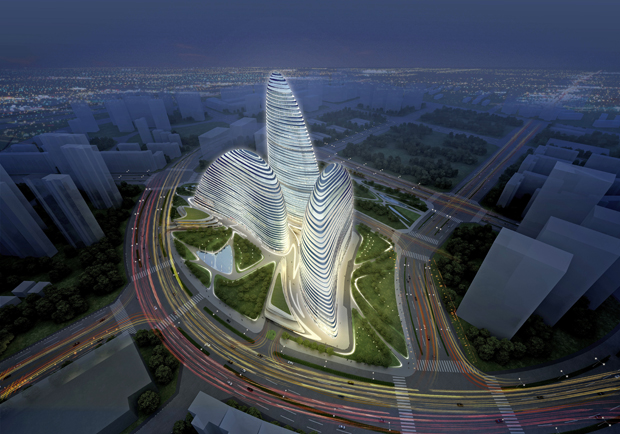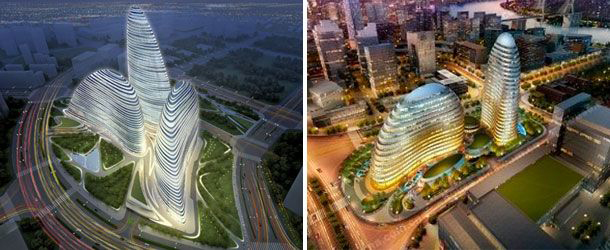
Zaha Hadid design becomes first 'faked' building
Chinese developers 'pay homage' to Beijing's Wangjing Soho, and they're due to complete before the original
The downside of launching a successful product in China is that you'll inevitably see it pirated and put up for sale within weeks, sometimes even days. China's particular approach to copyright and counterfeiting has allowed iPads, iPhones and - in some cases - even entire fake Apple stores to proliferate, seemingly without hinderance, on city high streets.
But where it was once just the baubles and decorations of the luxury goods market that sold for a pittance in shopping malls such as Beijing's Pearl Market, now it seems, some unscrupulous property developers may be beginning to fake buildings.
Der Speigel reports that an unauthorised 'copy' of Zaha Hadid's Wangjing Soho office and retail complex in Beijing is being built in Chongqing, the emerging mega city 1,000 miles south west of the capital. What's more, Chongqing's copy of this 521,265m², 39 storey complex, dubbed Meiquan 22nd Century, could even be completed before the original is due to be finished, in 2014.
Satoshi Ohashi, Zaha Hadid Architects project director for the Beijing complex, explained to Der Spiegel, "it is possible that the Chongqing pirates got hold of some digital files or renderings of the project."
Yet You Yunting, a Shanghai-based lawyer who founded an online journal covering intellectual property issues, said China's copyright law includes protection for works of architecture. He has studied the 'copy' of the Hadid project, and says "The two versions of the complex are quite similar." He believes SOHO, the company that commissioned Hadid has a good chance of winning any litigation it might care to bring. However, he adds that even if it won it would be unlikely that the 'fake' Hadid would be pulled down, though compensation would be payable.

For their part, the developers of Meiquan 22nd Century, talking to The South China Morning Post, say their design is not a copy. But Hadid is not the first Westerner to see her architecture paid homage to in China. Last year, citizens of the Austrian town of Hallstatt were shocked to discover Chinese architects had photographed their homes and were building a doppelgänger version of the UNESCO World Heritage site in the south of the country.
Der Spiegel suggests that world-class architects may not object to having their works ripped off. Hadid is quoted as saying, so long as her cloned buildings include some innovative new mutations then any copy "could be quite exciting".
Meanwhile, Rem Koolhaas has described China's planners as 'Photoshop designers'. The German publication reprints Koolhaas' suggestions that "Photoshop allows us to make collages of photographs," adding "Design today becomes as easy as Photoshop, even on the scale of a city."
Of course, as with other areas of creative endeavour, it's perhaps easier for the stars at the top to take a relaxed attitude towards copyright, having made their fortunes. But can today's graduates gain the kind commissions to become the Pritzker prizewinners of the future, if the developers of tomorrow's cities simply cut and paste their new developments? Or is architecture - like recorded music - another area of creative production many of us now expect to enjoy gratis? Let us know what you think below.
For more on this story, read both Der Speigel and The South China Morning Post's articles. And for some truly original thinking, take a look at our inimitable Phaidon Atlas of 21st Century World Architecture.